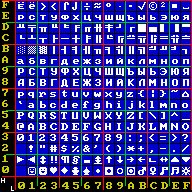Nibble
Nibble is a term used in computing and digital electronics to represent a four-bit aggregation, or half an octet (an octet being the same as a byte in most contexts). A nibble has sixteen possible values (2^4), ranging from 0 to 15, or in hexadecimal notation, from 0 to F. Understanding nibbles is crucial in fields such as computer science, information technology, and digital communication, where data representation and manipulation at the bit level are fundamental.
Overview[edit | edit source]
In digital systems, a nibble is the smallest unit of data that is half the size of a byte. Since a byte is typically eight bits, a nibble, by definition, consists of four bits. The significance of the nibble comes from its use in representing a single hexadecimal digit, which is a base-16 numeral system. This is particularly useful in computing for simplifying the representation of binary data. For example, the binary sequence 1010 can be more compactly represented as 'A' in hexadecimal, with 'A' signifying the decimal value 10.
Usage[edit | edit source]
Nibbles are widely used in various computing and digital electronics applications. One common use is in the representation of numbers and characters in a compact and more readable form, as in hexadecimal notation. They are also used in digital interfaces and protocols, where data might be transmitted or manipulated in nibble-sized chunks rather than byte-sized. This can be seen in certain types of serial communication protocols and in the programming of low-level hardware where memory and processing power are limited.
In addition to numerical data representation, nibbles are also used in error detection and correction mechanisms. For instance, a nibble can be used to store a checksum value for a small amount of data, helping to ensure data integrity during transmission or storage.
Historical Context[edit | edit source]
The term nibble is a play on the word "bite," implying a small chunk of data. Its use dates back to the early days of computing, where memory and storage were at a premium, and efficient data representation was crucial. The concept of the nibble allowed for more efficient use of the limited resources available at the time.
Technical Details[edit | edit source]
A nibble being 4 bits means it can represent sixteen different values. In binary, these values range from 0000 to 1111. In hexadecimal, the same range is represented as 0 to F, with the letters A to F representing the decimal values 10 to 15, respectively. This compact representation is particularly useful in programming and digital electronics, where it can make code more readable and data manipulation more efficient.
See Also[edit | edit source]
| This article is a stub. You can help WikiMD by registering to expand it. |
Search WikiMD
Ad.Tired of being Overweight? Try W8MD's physician weight loss program.
Semaglutide (Ozempic / Wegovy and Tirzepatide (Mounjaro / Zepbound) available.
Advertise on WikiMD
|
WikiMD's Wellness Encyclopedia |
| Let Food Be Thy Medicine Medicine Thy Food - Hippocrates |
Translate this page: - East Asian
中文,
日本,
한국어,
South Asian
हिन्दी,
தமிழ்,
తెలుగు,
Urdu,
ಕನ್ನಡ,
Southeast Asian
Indonesian,
Vietnamese,
Thai,
မြန်မာဘာသာ,
বাংলা
European
español,
Deutsch,
français,
Greek,
português do Brasil,
polski,
română,
русский,
Nederlands,
norsk,
svenska,
suomi,
Italian
Middle Eastern & African
عربى,
Turkish,
Persian,
Hebrew,
Afrikaans,
isiZulu,
Kiswahili,
Other
Bulgarian,
Hungarian,
Czech,
Swedish,
മലയാളം,
मराठी,
ਪੰਜਾਬੀ,
ગુજરાતી,
Portuguese,
Ukrainian
Medical Disclaimer: WikiMD is not a substitute for professional medical advice. The information on WikiMD is provided as an information resource only, may be incorrect, outdated or misleading, and is not to be used or relied on for any diagnostic or treatment purposes. Please consult your health care provider before making any healthcare decisions or for guidance about a specific medical condition. WikiMD expressly disclaims responsibility, and shall have no liability, for any damages, loss, injury, or liability whatsoever suffered as a result of your reliance on the information contained in this site. By visiting this site you agree to the foregoing terms and conditions, which may from time to time be changed or supplemented by WikiMD. If you do not agree to the foregoing terms and conditions, you should not enter or use this site. See full disclaimer.
Credits:Most images are courtesy of Wikimedia commons, and templates, categories Wikipedia, licensed under CC BY SA or similar.
Contributors: Prab R. Tumpati, MD

